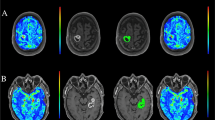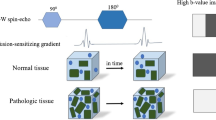Abstract
Introduction
Few studies assessed diffusion tensor imaging (DTI) changes in the acute phase of subarachnoid haemorrhage (SAH). We prospectively evaluated DTI parameters in the acute phase of SAH and 8–10 days after and analysed whether changes could be related to SAH severity or to the development of delayed cerebral ischemia (DCI).
Methods
Apparent diffusion coefficient (ADC) and fractional anisotropy (FA) changes over time were assessed in a prospective cohort of patients with acute SAH. Two MRI studies were performed at <72 h (MRI-1) and 8–10 days (MRI-2). DTI parameters were recorded in 15 ROIs. Linear mixed regression models were used.
Results
Forty-two patients were included. Subtle changes in DTI parameters were found between MRI-1 and MRI-2. At the posterior limb of internal capsule (PLIC), a weak evidence of a 0.02 mean increase in FA (p = 0.064) and a 17.55 × 10−6 mm2/s decrease in ADC (p = 0.052) were found in MRI-2. Both FA and ADC changed over time at the cerebellum (increase of 0.03; p = 0.017; decrease of 34.73 × 10−6 mm2/s; p = 0.002, respectively). Patients with DCI had lower FA values on MRI-1 and lower ADC on MRI-2, although not reaching statistical significance, compared to non-DCI patients. DTI parameters on MRI-1 were not correlated to clinical admission scales.
Conclusion
ADC and FA values show subtle changes over time in acute SAH at the PLIC and cerebellum although not statistically associated with the severity of SAH or the occurrence of DCI. However, DTI changes occurred mainly in DCI patients, suggesting a possible role of DTI as a marker of DCI.




Similar content being viewed by others
References
Helbok R, Kurtz P, Vibbert M, et al. (2013) Early neurological deterioration after subarachnoid haemorrhage: risk factors and impact on outcome. 266–270. doi: 10.1136/jnnp-2012-302804
Connolly ES, Rabinstein a a, Carhuapoma JR et al (2012) Guidelines for the management of aneurysmal subarachnoid hemorrhage: a guideline for healthcare professionals from the American Heart Association/American Stroke Association. Stroke 43:1711–1737. doi:10.1161/STR.0b013e3182587839
Hackett ML, Anderson CS (2000) Health outcomes 1 year after subarachnoid hemorrhage: an international population-based study. The Australian Cooperative Research on Subarachnoid Hemorrhage Study Group. Neurology 55:658–662
Rinkel GJE, Algra A (2011) Long-term outcomes of patients with aneurysmal subarachnoid haemorrhage. Lancet Neurol 10:349–356. doi:10.1016/S1474-4422(11)70017-5
Pegoli M, Mandrekar J, Rabinstein AA, Lanzino G (2015) Predictors of excellent functional outcome in aneurysmal subarachnoid hemorrhage. J Neurosurg 122:414–418
Jellison BJ, Field AS, Medow J et al (2004) Diffusion tensor imaging of cerebral white matter: a pictorial review of physics, fiber tract anatomy, and tumor imaging patterns. Am J Neuroradiol 25:356–369
Mori S, Zhang J (2006) Principles of diffusion tensor imaging and its applications to basic neuroscience research. Neuron 51:527–539
Provenzale JM, Isaacson J, Chen S et al (2010) Correlation of apparent diffusion coefficient and fractional anisotropy values in the developing infant brain. Am J Roentgenol 195:W456–W462. doi:10.2214/AJR.10.4886
Pluta RM, Hansen-Schwartz J, Dreier J et al (2009) Cerebral vasospasm following subarachnoid hemorrhage: time for a new world of thought. Neurol Res 31:151–158. doi:10.1179/174313209X393564
Leng LZ, Fink ME, Iadecola C (2011) Spreading depolarization. Arch Neurol 68:31–36. doi:10.1001/archneurol.2010.226
Yuksel S, Tosun YB, Cahill J, Solaroglu I (2012) Early brain injury following aneurysmal subarachnoid hemorrhage: emphasis on cellular apoptosis. Turk Neurosurg:529–533. doi:10.5137/1019-5149.JTN.5731-12.1
Condette-Auliac S, Bracard S, Anxionnat R et al (2001) Vasospasm after subarachnoid hemorrhage: interest in diffusion-weighted MR imaging. Stroke 32:1818–1824. doi:10.1161/01.STR.32.8.1818
Liu Y, Soppi V, Mustonen T et al (2007) Subarachnoid hemorrhage in the subacute stage: elevated apparent diffusion coefficient in normal-appearing brain tissue after treatment. Radiology 242:518–525
Jang SH, Kim HS (2015) Aneurysmal subarachnoid hemorrhage causes injury of the ascending reticular activating system: relation to consciousness. 667–671
Jang SH, Choi BY, Kim SH et al (2014) Injury of the mammillothalamic tract in patients with subarachnoid haemorrhage: a retrospective diffusion tensor imaging study. BMJ Open 4:e005613–e005613. doi:10.1136/bmjopen-2014-005613
Yeo SS, Choi BY, Chang CH et al (2012) Evidence of corticospinal tract injury at midbrain in patients with subarachnoid hemorrhage. Stroke 43:2239–2241. doi:10.1161/STROKEAHA.112.661116
Frontera JA, Claassen J, Schmidt JM et al (2006) Prediction of symptomatic vasospasm after subarachnoid hemorrhage: the modified fisher scale. Neurosurgery 59:21–27. doi:10.1227/01.NEU.0000218821.34014.1B
Hijdra a, Brouwers PJ, Vermeulen M, van Gijn J (1990) Grading the amount of blood on computed tomograms after subarachnoid hemorrhage. Stroke 21:1156–1161. doi:10.1161/01.STR.21.8.1156
Frontera J a, Fernandez a, Schmidt JM et al (2009) Defining vasospasm after subarachnoid hemorrhage: what is the most clinically relevant definition? Stroke 40:1963–1968. doi:10.1161/STROKEAHA.108.544700
Vergouwen MDI, Vermeulen M, Muizelaar JP, et al. (2010) Definition of delayed cerebral ischemia after aneurysmal subarachnoid hemorrhage as an outcome event in clinical trials and observational studies proposal of a multidisciplinary research group. doi: 10.1161/STROKEAHA.110.589275
Fisher CM, Kistler JP, Davis JM (1980) Relation of cerebral vasospasm to subarachnoid hemorrhage visualized by computerized tomographic scanning. Neurosurgery 6:1–9
Kistler JP, Crowell RM, Davis KR et al (1983) The relation of cerebral vasospasm to the extent and location of subarachnoid blood visualized by CT scan: a prospective study. Neurology 33:424–436
Sehba FA, Pluta RM, Zhang JH (2011) Metamorphosis of subarachnoid hemorrhage research: from delayed vasospasm to early brain injury. Mol Neurobiol 43:27–40. doi:10.1007/s12035-010-8155-z
Nucifora PGP, Verma R, Lee S, Melhem ER (2007) Diffusion-tensor MR imaging. Radiology 245:367–384. doi:10.1148/radiol.2452060445
Ebisu T, Naruse S, Horikawa Y et al (1993) Discrimination between different types of white matter edema with diffusion-weighted MR imaging. J Magn Reson Imaging 3:863–868
Busch E, Beaulieu C, Crespigny A De, Moseley ME (1998) Diffusion MR imaging during acute subarachnoid hemorrhage in rats
Brissaud O, Amirault M, Villega F et al (2010) Efficiency of fractional anisotropy and apparent diffusion coefficient on diffusion tensor imaging in prognosis of neonates with hypoxic-ischemic encephalopathy: a methodologic prospective pilot study. Am J Neuroradiol 31:282–287. doi:10.3174/ajnr.A1805
Hunt RW, Neil JJ, Coleman LT et al (2004) Apparent diffusion coefficient in the posterior limb of the internal capsule predicts outcome after perinatal asphyxia. Pediatrics 114:999–1003. doi:10.1542/peds.2003-0935-L
Schmidt JM, Wartenberg KE, Fernandez A et al (2008) Frequency and clinical impact of asymptomatic cerebral infarction due to vasospasm after subarachnoid hemorrhage. J Neurosurg 109:1052–1059. doi:10.3171/JNS.2008.109.12.1052
Wartenberg KE, Sheth SJ, Michael Schmidt J et al (2011) Acute ischemic injury on diffusion-weighted magnetic resonance imaging after poor grade subarachnoid hemorrhage. Neurocrit Care 14:407–415. doi:10.1007/s12028-010-9488-1
Frontera JA, Ahmed W, Zach V et al (2015) Acute ischaemia after subarachnoid haemorrhage, relationship with early brain injury and impact on outcome: a prospective quantitative MRI study. J Neurol Neurosurg Psychiatry 86:71–78. doi:10.1136/jnnp-2013-307313
Sviri GE, Lewis DH, Correa R et al (2004) Basilar artery vasospasm and delayed posterior circulation ischemia after aneurysmal subarachnoid hemorrhage. Stroke 35:1867–1872. doi:10.1161/01.STR.0000133397.44528.f8
Qureshi AI, Sung GY, Razumovsky AY et al (2000) Early identification of patients at risk for symptomatic vasospasm after aneurysmal subarachnoid hemorrhage. Crit Care Med 28:984–990
Hijdra A, Van Gijn J, Nagelkerke NJD, et al. (1988) Prediction of delayed cerebral ischemia, rebleeding, and outcome after aneurysmal subarachnoid hemorrhage. 1250–1257. doi: 10.1161/01.STR.19.10.1250
Acknowledgements
We would like to thank the medical and nursing staff of Serviço de Cuidados Neurocríticos and Unidade Cerebro-Vascular at Hospital de São José, and the Neuroradiology Department physicians and technicians for collaboration during patient inclusion. We also thank Dr.Rui Marcelino for helping with the database. Dr. Fragata was supported by a grant of the Sociedade Portuguesa de AVC (SPAVC) sponsored by Tecnifar.
Author information
Authors and Affiliations
Corresponding author
Ethics declarations
We declare that all human and animal studies have been approved by the CHLC Ethics Committee and have therefore been performed in accordance with the ethical standards laid down in the 1964 Declaration of Helsinki and its later amendments. We declare that all patients gave informed consent prior to inclusion in this study.
Conflict of interest
We declare that we have no conflict of interest..
Rights and permissions
About this article
Cite this article
Fragata, I., Canhão, P., Alves, M. et al. Evolution of diffusion tensor imaging parameters after acute subarachnoid haemorrhage: a prospective cohort study. Neuroradiology 59, 13–21 (2017). https://doi.org/10.1007/s00234-016-1774-y
Received:
Accepted:
Published:
Issue Date:
DOI: https://doi.org/10.1007/s00234-016-1774-y




